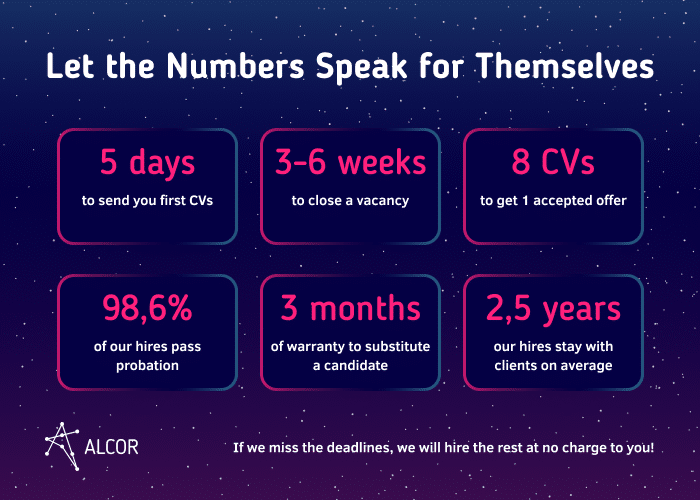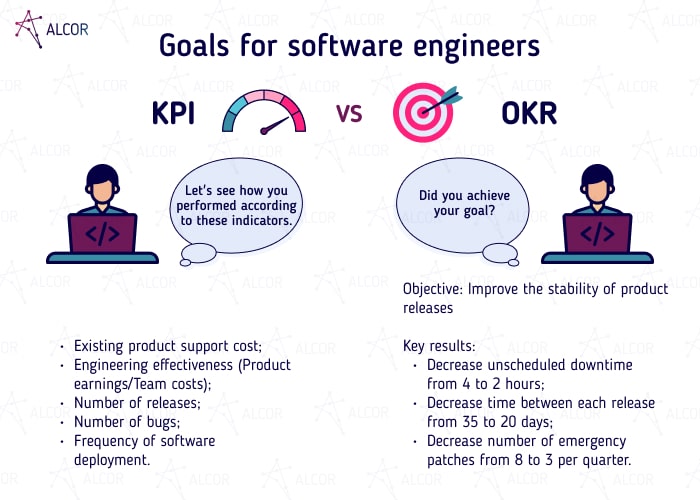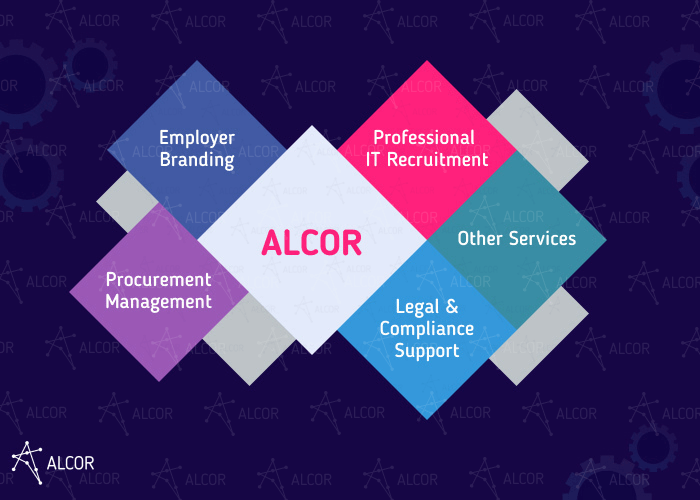Setting performance goals every quarter is like adding jet fuel to a company’s engine — it usually results in a remarkable 31% boost in returns. Yet, many team leads face a common challenge: even though they have a clear vision for overall company goals, they still struggle to define specific objectives for individual programmers. Picture it as a puzzle and your software engineers as the pieces. Once you’ve understood how to set and prioritize the objectives of the “pieces,” the puzzle is put together for the long haul. But how to do that effectively?
I’m Dmytro Ovcharenko, CEO at Alcor, a leading provider of R&D center services and IT staffing in South America and Eastern Europe. In this article, I’ll talk about the critical approaches and principles for setting software engineer goals. Plus, I’ll toss in some valuable tips and examples of both long-term and short-term performance goals for software developers. So, buckle up, and let’s dive in!

Setting Goals for Engineers: Main Approaches
There are various techniques and frameworks for setting and planning team goals. Take, for instance, the widely recognized Key Performance Indicator (KPI), a tool that aids teams in monitoring results and task feasibility. It’s like a compass guiding a ship through the business landscape. KPIs shine when a company needs to gauge its condition and assess the overall performance of its strategy.
However, relying solely on KPIs for team evaluation is a bit like seeing the world through a narrow lens — it can distort the actual situation and create an unhealthy atmosphere within the company. This distortion can stem from various factors, such as incorrectly set indicators or uneven work distribution within the team. But, the primary culprit is often a poorly chosen indicator when evaluating teamwork.
Engineering team managers are better off embracing the Objectives and Key Results (OKRs) method to minimize such situations. It allows the linking of development goals for software engineers with business goals. Plus, this method ensures that every employee contributes to bringing the company’s strategy to life. In this way, each employee makes an effort to implement the company’s strategy. Nowadays, OKRs are used by industry leaders, multinational corporations, and global brands such as Intel, Google, LinkedIn, Zynga, Twitter, Oracle, Netflix, BMW, Disney, Salesforce, and Samsung.
Key Results and Key Indicators: What Is the Difference?
The main difference between OKR and KPI lies in the metric’s scope.
KPI is a quantitative index that assesses a company’s strategic and tactical goals. Typically, an employee’s KPI comprises 3-5 indicators, each shedding light on different vital aspects of the product or company. Evaluation involves comparing the actual, minimum, and maximum target values, offering a comprehensive view.
On the flip side, OKR is a quality indicator tailored for project management. It consists of an objective that outlines what needs to be achieved, as well as key results that detail precisely how to reach the goal. In this system, each software engineer can pursue 3-4 objectives, with each goal branching into 2-5 results.
Now, let’s peek into some examples of software engineer goals:

How to Set Up Goals for Engineers?
Setting goals for software developers may seem like navigating a complex maze, but fear not — there are guiding principles to simplify the process.
Set goals from top to bottom
Imagine it as building a sturdy pyramid where your software developers’ day-to-day tasks and responsibilities align seamlessly with the broader business goals. You create a unified dashboard of objectives by implementing the OKR system from top to bottom — from company managers to department heads and from heads to performers. This streamlines the workflow and amps up the team’s overall productivity.
Use a SMART approach
SMART is an acronym for a set of characteristics needed to craft clear goals for software developers. Such an approach helps define the desired outcome and provides a sense of direction. According to this approach, the SMART goals for software engineers should be:
- Specific. Picture the goal as a well-defined destination on a map. It needs to be clear and specific, setting a distinct work direction. Vague objectives can lead the team astray, so clarity is vital.
- Measurable. Establish specific criteria for measuring progress, ensuring everyone stays focused, meets deadlines, and tracks their advancement along the way. It’s like having signposts to guide the team.
- Achievable. Think of your goal as a mountain to climb. It should be ambitious yet realistic and take into account the team’s experience, available resources, and constraints. If a career goal for software developers seems like an insurmountable peak or performance isn’t up to par, it’s wise to step back, reassess, and choose a more achievable objective.
- Relevant. The software developer’s goals must be meaningful and consistent with the company’s primary goals. If an objective feels challenging or doesn’t quite fit, consider setting an intermediate short-term goal to test the waters.
- Time-bound. The goal should be limited in time. Establishing time frames and boundaries makes the management process more controllable. For instance, you can establish monthly or annual goals for software developers, depending on their complexity.
As you can see, the magic behind SMART goals for software developers lies in their explicitness. The availability of clear objectives, the means to achieve them, timeframes, and desired results help programmers stay on the right track. This approach can broaden their qualifications, boost soft skills, create a more cohesive team, and develop leadership abilities.
Here are a couple of SMART goal examples for software developers:
|
Objective: Resolve problems in UX Key results:
|
|
Objective: Increase traffic to the website Key results:
|
These objectives are SMART as they are:
- Specific (to increase traffic to the website);
- Measurable (to reduce recovery time by 40%);
- Attainable (fix bugs by the end of the quarter);
- Relevant for business development;
- Limited in time (within 4 months, by the end of the quarter, etc.).
Collect feedback
Conduct brainstorming sessions with your team on professional goals for software engineers to collect feedback and use it to adjust the objective. This will help to avoid common mistakes and clear up any misconceptions. If the team thinks a particular goal is unachievable, it’s best to know about that before setting it as an objective. You gain valuable insights by being receptive to fresh ideas, varied perspectives, and open dialogue. It’s like having a compass for success; steer the ship with collective wisdom, and your professional goals will be on a solid course.
Hold one-on-one meetings
Stay connected with your colleagues through regular one-on-one meetings about their goals. Offer training, celebrate successes, and pinpoint any obstacles. This keeps conflicts between personal and team goals at bay. Resolving issues regularly with your team will also ensure they don’t get lost in the daily workflow.
Tips for Setting Goals for Senior Developers
Let’s bust a myth: self-development isn’t just for junior or middle software engineers. Senior developers should stay relevant and fulfilled in the fast-paced tech world. Continuous learning isn’t just a personal gain — it ripples through the development team and fuels overall company growth.
So, what objectives can you set as a manager? Let’s have a look at five types of senior software engineer goals and their examples:
1. Job goals
Career goals for software engineers are long-term objectives that chart an employee’s professional growth map. These general goals define a certain level of seniority an employee wants to obtain or relate to the specific duties a developer may complete while working. By setting job goals for your senior programmers, you can identify the skills or experience they may need to become a qualified candidate for a specific role. Plus, these goals serve as a good source of motivation for them to advance in their job.
Career aspiration examples for software engineers:
- Secure a position as a software architect in the current work pace.
- Develop a comprehensive architectural vision for projects to ensure long-term scalability and maintainability.
- Gain expertise in project management and delivery to become a tech lead.
2. Technical goals
As they say: “There is no limit to perfection.” Being a senior-level software developer not only implies that they are capable of fulfilling tasks by using their technical knowledge, hands-on experience, and coding skills but also that they can manage projects and enhance overall product development. To do so, it’s essential for your senior developers to always stay updated on the latest IT trends and innovations by broadening their tech stack.
Examples of SMART goals for software engineers:
- Learn Java programming language to leverage Big Data for product development and business growth.
- Master cloud services and infrastructure as a service (IaaS) platforms for efficient application deployment and management.
- Strengthen the security posture of the software by implementing best practices like data encryption and multifactor authentication to address potential vulnerabilities.
3. Interpersonal goals
As much as code quality and technical skills matter, communication and collaboration are what really make a software engineer great. Long past those days when soft skills were inferior to hard skills. Research conducted by Fortune 500 CEOs has shown that 75% of long-term job success actually depends on the level of staff‘s interpersonal skills.
Advanced soft skills are especially vital for senior-level specialists, as they keep all the processes rolling in the team. Communication, emotional intelligence, critical thinking, adaptability, and time management are just a few skills that should be in the arsenal of your senior programmers.
Examples of software developer objectives:
- Strengthen communication skills to ensure clear and concise information exchange within the development team.
- Enhance the ability to collaborate with team members in problem-solving and decision-making.
- Improve emotional intelligence regarding feedback reception among team members, ensuring a constructive and growth-oriented response to both positive and constructive criticism.
Learn about the benefits of hiring Romanian senior developers in our article on software outsourcing to Romania!
4. Leadership goals
Any senior software engineer has the potential to become a team lead or an engineering manager. But to achieve this long-term goal, it’s essential to develop and enhance leadership skills. These include thoughtfulness, responsibility, reliability, organization, delegation, conflict resolution, time management, mentorship skills, and the ability to see the bigger picture, to name just a few.
Leadership smart goals examples:
- Actively contribute to the team’s growth by mentoring junior developers and sharing knowledge.
- Foster a motivating and empowering team environment by actively supporting team members in their professional growth and recognizing their achievements.
- Develop skills to address and resolve conflicts within the team effectively.
5. Community goals
Such senior software engineer goals have a broader and higher purpose, which can benefit your team of software developers and the entire tech community. The most common ways to achieve community goals include sharing professional experiences like participating in field conferences and events or hosting workshops and webinars. There is also a way to make a difference from the practical part, like participating in open-source projects and local tech initiatives.
Examples of developer goals:
- Actively participate in local or virtual tech meetups.
- Contribute to technical Q&A platforms by answering questions, providing solutions, and sharing insights.
- Develop educational content such as tutorials, courses, or guides to help others in the community enhance their skills.
So, how to effectively set these goals for software developers? Here are some essential tips for your consideration:
- Access current competencies of your senior developers to identify skills for further improvement;
- Consider team and company objectives as well as employee’s career aspirations to set goals;
- Define short-term and long-term goals, breaking them down into actionable steps;
- Track progress by conducting regular check-ins, providing feedback and reports, and adjusting goals, if necessary.
The Principles of Establishing Development Goals for Software Engineers
Each team member has an individual attitude towards professional goals: some aim for leadership, while others find comfort and fulfillment in being specialists. This diversity underscores the importance of a personalized approach.
Imagine it as tailoring a suit — understanding each tech talent’s career goals is not merely about setting long-term objectives but weaving a connection beyond formal targets. This approach creates a fertile ground for growth, allowing every team member to chase their professional dreams. Consider these characteristics and principles of performance goals for software engineers to gauge their effectiveness.
A good goal is ambitious and requires synergy.
First, the engineering manager needs to set ambitious goals for each team member, designed individually but considering the entire team’s capabilities — to force everyone to focus on the objective. With this approach, your team will grow beyond the specific boundaries you set for them.
The goal set for an individual employee should develop the entire team.
For example, the goal “to read a book” is too personal — it does not bring value to your team. It can only help grow an individual junior employee. And the goal of “conducting training for colleagues” is successful both for the performer (it is necessary to prepare a lecture) and for employees (acquaintance with new material).
The goal is not a KPI.
It is essential to understand that the goal is not a performance metric for a working project but a direction for its development. KPI is an instrument, whereas a goal is a final point you want to reach.
All in all, proper goal setting is the key to the engineering team and organization. This complex process includes many components, including each participant’s potential, company goals, and the team’s interaction.
2 Long-term Goal Examples for Software Developers
Performance goals for software developers can be divided into short-term and long-term ones. Think of them as a staircase, where short-term goals are the smaller steps leading to the grand ascent of long-term career objectives. Basically, the main difference between short-term and long-term goals for a software developer lies in the time frame, scope, and level of detail involved in each type of goal.
Long-term goals focus on more broad and significant achievements, making them more strategic with much longer time frames. Short-term goals, on the other hand, tend to be more specific and detailed, with pre-defined timeframes and deadlines.
| Short-term goals | Long-term goals | |
| Time-frame | several weeks to months | several months to years |
| Scope | narrowly focused and specific | extensive |
| Detail level | granular and detailed | high-level and strategic |
| Impact | immediate | gradual and accumulative |
Examples of long-term goals for software developers:
1) Technology Leadership
Objective: Evolve into a tech lead by guiding junior developers, shaping the technical direction of projects, and contributing to the growth and success of the entire development team.
Measurable Outcomes:
- Positive feedback and success stories from mentees who have benefited from guidance.
- Promotion to a senior leadership role with increased responsibilities.
- Recognition as a key influencer in shaping the technical culture of the organization.
2) Expert Contributor to Open-Source Communities
Objective: Become a recognized expert contributor to major open-source projects by fostering collaboration and making meaningful contributions to the global development community.
Measurable Outcomes:
- Recognition as a top contributor within specific open-source communities.
- Successful integration of contributed features or improvements into major project releases.
- Elevated visibility in the development community through participation in conferences and events.
Fuel long-term success with Polish. Romanian, Bulgarian, and Ukrainian developers. Explore IT outsourcing to Eastern Europe!
3 Short-term Goal Examples for Software Engineers
1) Code Quality Enhancement
Objective: Improve the overall code quality of the software development projects by addressing and mitigating critical and major issues identified in code reviews. The aim is to achieve a 50% reduction in the number of critical and significant issues within the next three development cycles.
Results:
- Achieve a 50% reduction in the number of critical and major issues reported in code reviews over the next three development cycles.
- Ensure a high level of adherence to the newly established coding standards and best practices among the development team.
- Detect and address common issues early in development by integrating automated code analysis tools.
2) Mastery of a New Programming Language
Objective: Acquire proficiency in the Python programming language within the next six months by taking a specialized course. Demonstrate the ability to independently develop, debug, and optimize code for real-world applications.
Results:
- Demonstrate proficiency in writing clean, efficient, and maintainable Python code for various applications.
- Independently complete and showcase a series of hands-on projects, highlighting the ability to apply Python concepts to solve real-world problems.
3) Attain Professional Certification in Cloud Computing
Objective: Over the next six weeks, successfully complete a recognized professional certification program in cloud computing, gaining expertise in cloud services and deployment strategies.
Results:
- Successfully pass the certification exam and earn a recognized credential in cloud computing.
- Acquire a deep understanding of cloud computing concepts, services, and best practices.
- Apply acquired cloud skills to real-world scenarios to reinforce theoretical knowledge through hands-on experience.
It’s essential to mention that short-term goals should align with the SMART metrics as follows:
| SMART | #2 Example | #2 Example | #3 Example |
| Specific | reduction of critical and major issues in code reviews | mastery and practical use of the Python programming language | obtaining a professional certification in cloud computing |
| Measurable | 50% reduction in the number of critical and major issues within three development cycles | successful implementation of hands-on projects | successful completion of the certification exam |
| Achievable | implementing coding standards, providing training, and integrating automated tools | a six-month course which combines theoretical and practical parts | can be obtained within a short-term timeframe of six weeks |
| Relevant | broader objective of delivering high-quality software | staying up to date in the ever-evolving technology industry | highly requested skill in the modern IT landscape |
| Time-bound | 50% reduction in critical and major issues within the next three development cycles | six-month timeframe for achieving proficiency in Python | six-month course to gain competency in cloud computing |
If Your Goal Is Hiring Software Engineers, We Know How To Help ASAP!
Are you seeking skilled software developers who can effortlessly achieve ambitious goals to propel your company’s success? Look no further — Alcor got you covered!
We specialize in IT recruitment in Ukraine, Poland, Romania, Bulgaria, Mexico, Colombia, Argentina, Chile, and other EE and LATAM countries. Whether you need senior, lead, or C-level software developers for your US or Western European IT company, we’ve got the expertise to fill the vacancies. Our track record includes successful partnerships with notable names like People.ai, Dotmatics, and ThredUp.
But our services go beyond recruitment. We offer an all-in-one solution that grants you an R&D center. Our comprehensive offer includes an employer-of-record solution, legal & compliance services, employer branding, office lease negotiations, and IT infrastructure setup.

Let’s take a look at our exceptional Sift case study. This US-based IT company aimed to expand its team with over 30 developers. To turn this ambitious goal into reality, we engaged 13 recruiters to find perfect-fitted candidates and an account manager to handle operational functions. With an impressive 80% CV pass rate and a commitment to hiring 5 developers a month, our client achieved a fully supported R&D team of 30 programmers. Notably, we closed positions for 2 Infrastructure Engineers and a Ruby on Rails Developer within just a week!
If you want to achieve similar results, reach out to us!
